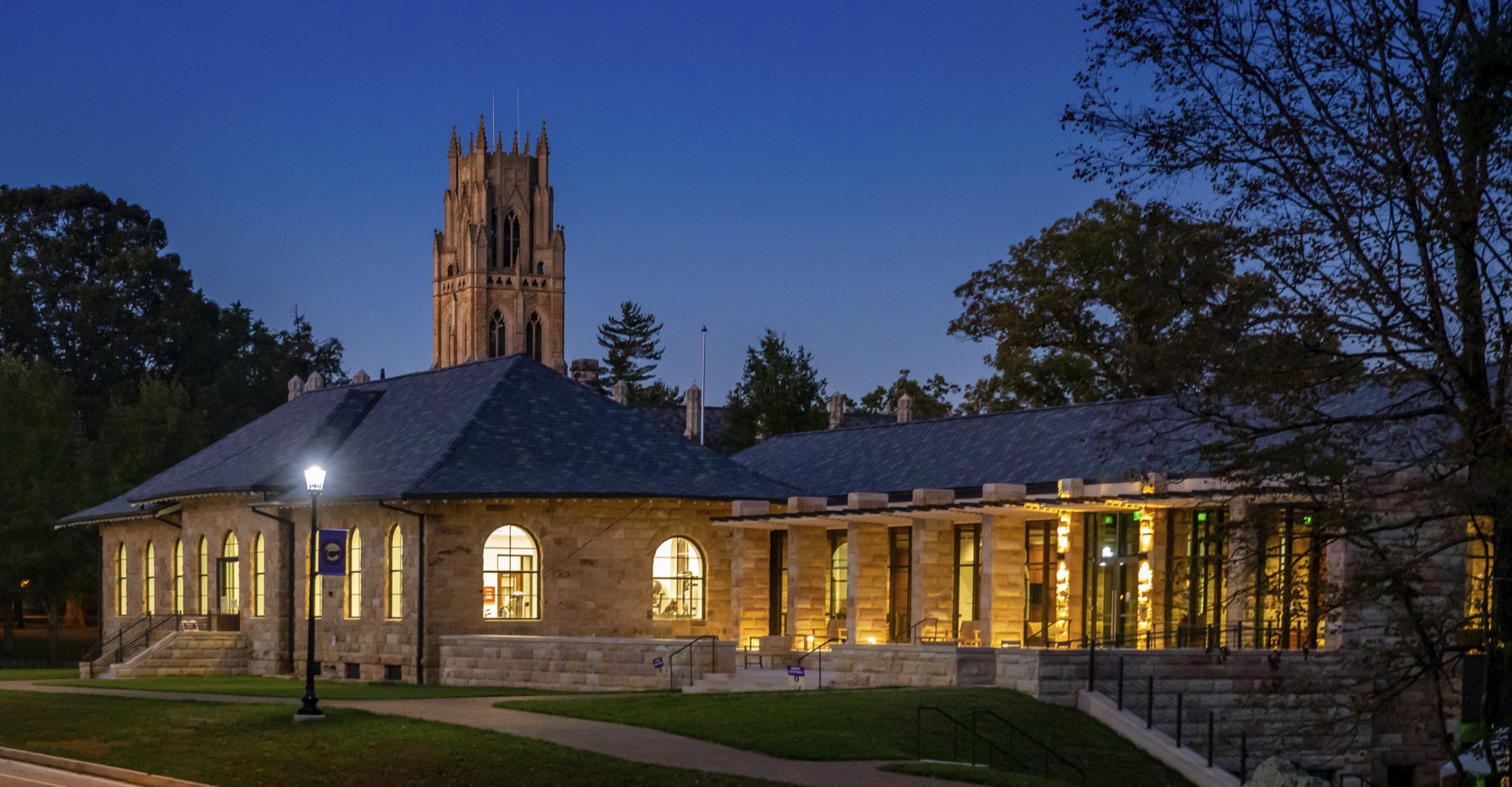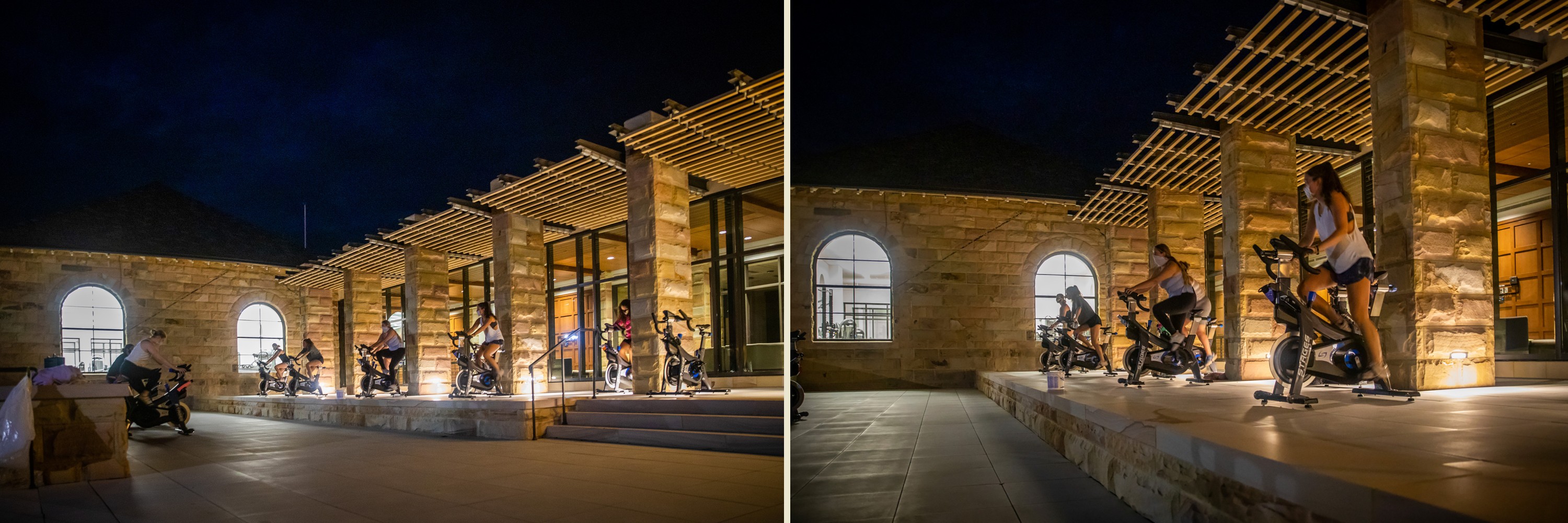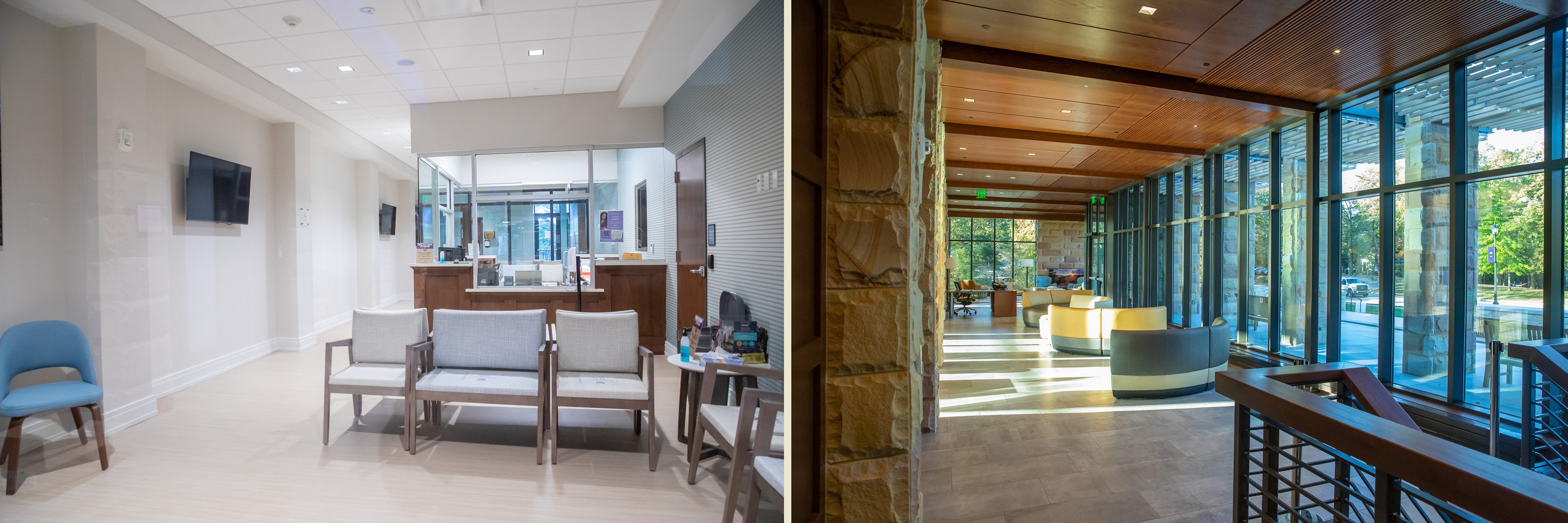
The Wellness Commons incorporates the former home of the University Bookstore and a spacious new addition. Photos by Buck Butler
A Home for Flourishing
With fitness, health and counseling services, and the Sewanee Outing Program all housed in one spectacular location, Sewanee’s newly opened Wellness Commons relocates student well-being to the center of campus and campus life.
By Tom Sanders
With a fitness tracker counting them, it would take a student 2,000 steps to walk from All Saints’ Chapel to the building where the University Wellness Center was located until just a few weeks ago. Taking this walk required them to step across an important conceptual divide. The location strongly suggested that wellness was the presence or absence of a pathology, and students went there (next to the hospital and physicians’ offices) to be fixed. Once there, they could receive balm for their poison ivy, a script for their strep throat, or counseling for their stress.
By contrast, the newly opened Wellness Commons, at the site of the historic University Book and Supply Store (and incorporating the historic structure), is only about 50 steps from All Saints’ Chapel. Students still go to the University Wellness Center, but when they do, they enter a space where their flourishing is more important than merely being “fixed.”
Nicole Noffsinger-Frazier, associate dean of health and wellness, has been pointing the work of her staff toward flourishing since she took on the job several years ago, and the new Wellness Commons embodies that goal. “Moving health services from the edge of campus at the hospital to the very center of campus—next to McClurg and All Saints’—is more than a story about the location of a building. It reframes the way we think of well-being from pathology to flourishing. We take care of illness in our health services, but people enter this space as a way of expressing and building their wellness.”
Noffsinger-Frazier not only sees the Commons as a place where individuals change but one that will be a harbinger of community change by being “the primary place where students gather and meaningfully connect to build resilience, belonging, and lasting well-being.” She invokes the six pillars of flourishing modeled by Tyler VandwerWeele at the Harvard Human Flourishing Program. “We want to develop students who have clarity of purpose, character and virtue, strong relationships and belonging, happiness and life satisfaction, mental and physical health, and financial stability because students with high levels of flourishing are resilient, academically successful, have strong relationships, and are at lower risk for a variety of mental and physical health conditions.”
Coming Home
Entering the fully open and furnished Wellness Commons feels like a kind of homecoming. While the building is brand new, it feels as if it has always been there, an authentic Sewanee place. As a seen-it-all skeptic, I wondered why it felt that way, and asked.
Anna Stone, C’23, a student fitness instructor, answered quickly. “It’s a beautiful place, and we are lucky to have it. I think part of its charm is the interior wall that was an exterior wall of the existing building. And then all the windows really bring the outdoors into the space. Everywhere you look, you are looking at the outside.”
Noffsinger-Frazier agrees with Stone: “I really feel like I am standing in the center of campus when I'm inside the building. There is a sense of being connected to the outdoors even while inside. I also love that when Sarah [Rundle] teaches group fitness, she orients the directions to the class based on University Avenue and Gailor Hall (instead of saying turn to the left or the right)!”

Left: Wellness Coordinator Nysha Wallace leads a yoga class in a large multipurpose room with windows overlooking Gailor Hall. Right: The FitWell cardio room, where some machines are marked off-limits to allow for appropriate distancing.
“It’s the music that’s playing,” says Wellness Coordinator Nysha Wallace. “Those songs on the sound system were very carefully selected.” Wallace, who works with other organizations on campus to build cross-campus programming, also teaches yoga in the building (and on the football field under the stars and with goats from the farm) and works with a group of peer health educators.
Sarah Rundle, the facility manager, thinks that feeling of authenticity comes from the way students are already starting to create community. “It feels authentic to me because of the people. Because of the connections, relationships, and collaborations that the students are already finding within this space.”
These immediate and clear impressions bring to mind Louis Sullivan’s dictum that “form ever follows function.” It’s easy to imagine flourishing in the Wellness Commons because of the way it exists in space.
Moving Is Learning
Rundle is always in motion and would have been fine with her 4,000-step round trip to the old building. “If I don’t get in 5,000 steps by 1 o’clock, I just don’t feel right,” she says. She teaches group fitness classes, and she also teaches a class that gives Sewanee students a credential from the American Council on Exercise (ACE) that allows them to be fitness instructors both at Sewanee and after they leave. As Noffsinger-Frazier gives a tour of the building, Rundle comes in and out of the conversation while accomplishing a dozen other tasks. “We want to give this space to the students,” she says, popping in when the tour enters the fitness center.
On the original plans, the Johnson Family Fitness Center occupied the large main room that was formerly the University bookstore. Now, taking into account new understanding of fire codes, the fitness center is divided into two still quite large sections, visible through large windows: a strength training room and a cardio room. While the Belk Spin Room is across the hall in a newly built space, the three rooms work together seamlessly. At the beginning of the semester, before the building was fully operational, Rundle moved stationary bikes out onto the O’Brien Terrace in front of the building so students could do cycle training and maintain social distance.
Caroline Jessup, C’21, loves the stationary bikes. She is a student administrator, charged with opening the facility many days and often with closing. She is a key part of a large student staff of 25, which includes 10 students with work-study awards who work regular shifts that add up to eight hours per week, and another 15 who do ad hoc work at an hourly rate. Those students are teaching fitness and involved with running a facility that is open from 6 a.m. to 11 p.m. during the week, with somewhat more relaxed hours on Saturday and Sunday. “I didn’t really know I was going to like cycling so much,” Jessup says, “But those classes are so much fun.”
A psychology major, Jessup is hoping to go into clinical counseling after Sewanee, and the job at the Wellness Commons has become a highlight of her Sewanee experience. “I love this job, and I am so sorry that I will have to leave it after just one year,” she says. “This is such a great place to work as a student. We have a lot of autonomy, but we always know we have support.”
This kind of reaction is exactly what the wellness professionals are hoping for, not just because it fits the idea of flourishing but also because it situates wellness firmly in the educational mission of Sewanee. “I want students to have ownership of this space and to enter into a lifelong endeavor that passes on a little joy,” says Rundle. “I think the more I can give this building to the students, the closer they will be to flourishing, and fitness is a great platform to facilitate that process.”
Both Rundle and Noffsinger-Frazier teach in the College, and the Wellness Center has developed the Flourishing Resource Library, available to all students through the University’s online course-management system. While the concept of flourishing has been well-researched and documented (as evidenced by the resource library), Sewanee is seeking to make a distinctive contribution to the field. Karen Proctor, special assistant to the provost, has been working with Noffsinger-Frazier and others on what is called the Flourishing Initiative. “We are in the alpha phase of the initiative right now,” she says. “We are introducing students to this concept of flourishing to enable them to start on a journey to it. We are all on that journey, whether we recognize it or not. For a person who is in young adulthood, this is a critical moment to understand the outlines of that journey and start to build tools for it.”

Fitness instructors have gotten creative this semester by taking classes that are normally held indoors and moving them outside, like this spin class on the Wellness Commons terrace.
In the spring semester the initiative will move into a beta phase, with coursework and an interactive website related to flourishing. Eventually the project hopes to scale up and disseminate the approaches to other colleges. “Many colleges have concerns about whether or not their students are flourishing,” says Proctor. “But we think we have some solutions that other institutions will want to adopt. Moving the Wellness Center from the periphery of the campus to the very center of the campus is a visible sign of how we hope to affect our students and higher education as a whole.”
Nysha Wallace is using the physical features of the building to invite students in. “My next plan is to set up hot cider on the terrace when it gets colder. We’ll hand out cider and just ask students directly how they are doing.” As the wellness coordinator, Wallace is charged with working with students through a peer health program and working with colleagues across campus to develop wellness programming that touches as many people as possible. Wallace was hired in November 2019, so she has been on the job less than a year, and that year has been challenging for developing programs. “This semester has been pretty hard, actually,” she says. “Students are Zoomed out, and so we can’t just expect that we will have a program and people will attend. We have 1,700 students at Sewanee, and, with the building just now open, they are just starting to trickle in. So we have to be proactive. We’re going out and asking, ‘What do you want to see out of the Wellness Commons?’”
One important strategy for Wallace is building up a Peer Health Education Program. Currently, peer health educators live in the Peer Health House (formerly the Healthy Hut), one of Sewanee’s theme houses, and they have a work space in the Wellness Commons. The Peer Health House is a living and learning community, which allows diverse people with common interests to live and learn together. Living and learning communities are considered a best practice in higher education, and Wallace is working hard to ensure that, while all the residents share the interest of peer education, the community is diverse and inclusive in other ways. “At those times when students are wary of messages from the University as a whole, they will trust each other,” she says. “We think it is really important that we have a strong group of peer health educators, and we are doing everything we can to accomplish that.”
Another student group with which Wallace is working is called Active Minds, a local instance of a national organization with more than 600 institutional members that focuses on wellness, especially mental health. Sewanee’s group is raising funds to build awareness programs and partnering with local organizations such as the Blue Chair to secure resources that enhance the group’s ability to do peer education.
Wallace came to Sewanee from the Bronx, New York, where she was a yoga instructor, and yoga is a pillar of wellness programming. A large multipurpose room in the Wellness Commons provides a beautiful and welcoming space for yoga (as well as other group fitness classes throughout the day), and Wallace is glad to be back in an instructor role in that space. “Yoga is home,” she says. With Rundle, Wallace has partnered with the football team to do yoga under the stars in the evenings and goat yoga in partnership with the University Farm. She also collaborated with two students in the University Choir to present an online concert entitled “The Road Home.” As the year progresses, Wallace will be building partnerships with other groups on campus.
Health by Design
While the fitness center and a bookstore outpost occupy the first floor of the Wellness Commons, the downstairs is home to the Wellness Center and the Sewanee Outing Program. The Lee and Dorothy Thomas Wellness Center has two constituent programs: University Health Services and Counseling and Psychological Services (CAPS). While flourishing manifests publicly, health, counseling, and psychiatric issues are confidential, and the Wellness Center has more closed doors and hallways than the fitness center. Behind the closed doors, students benefit from effective, evidence-based treatment from a talented and multidisciplinary staff led by Karen Tharp in Health Services and Ashley Liston-Avnaim in CAPS. At the Elliott Park end of the building, the feeling of outside on the inside returns in the McClain Conference Room, and a bank of offices look out toward Gailor.

Left: On the lower level of the commons, the University Wellness Center welcomes students for both health and counseling services. Right: On the main floor, the lobby features a wall of windows overlooking University Avenue.
On the All Saints’ Chapel end of the hall, the Sewanee Outing Program is taking up residence in spaces that John Benson, director of the program, says will provide for a lot of synergies. “People don’t know this, but we have always had a gear room upstairs in the Bishop’s Common; we’ve always had an outing pantry in another room upstairs; and we’ve always had a bike shop in the basement of the Women’s Center. Now all those things will be together in a functioning, convenient space. We’ll have a patio to stage trips, and we will now for the first time have a functioning kitchen to prepare for trips.” Benson is happy about being close to the McClurg Dining Hall, and grateful for the space, but what really sold him on moving from the comfortable space in the BC was the reaction of his student leaders. “We have 90 student leaders for the program, and they were really excited when they saw the space. So I’m happy. Not only are our resources more conveniently located adjacent to each other, but our students are energized. That’s what makes our program work.”
One final note is that Benson is grateful to the Ayres family for the gifts that made the space possible and particularly grateful that they made the contributions in recognition of former Dean of the College and founder of the Sewanee Outing Program Stephen E. Puckette II, C’49. “I know it’s family [Puckette was Benson’s father-in-law], but, still, I think it’s great that he is recognized for founding the Sewanee Outing Program and making sure students had guided access to the outdoors, and I am personally grateful for the generosity of the Ayres family.”
When Benson and his students finally move in, the finishing touch will be hanging the Hugh Caldwell paddles on the wall. “Right where they have always been,” he says. While Dean Puckette founded the outing program in the early 1970s, he was inspired by his friend Caldwell, who took students canoeing and on bike trips. “Every year, he would even walk to Sewanee from Chattanooga to demonstrate human capabilities and what early students would have had to go through.”
FitWell
In taking possession of the fitness center, staff and students have also crowd-sourced an unofficial (and rapidly embraced) name for the facility. They are calling it “FitWell.” FitWell tracks with the staff’s focus on fitness and group fitness as a primary activity taking place there. And that activity tracks perfectly with the continuing mission of University Health Services, which continues to provide the traditional balm and comfort. “Fitness is a great platform for well-being,” says Rundle. “It’s not about body shaming. It’s about movement and taking control of your sense of wellness. I really like the thoughtful research that has gone into fitness and how it leads to body positivity. Movement has been shown to have a mood benefit. And group fitness is really important because it helps with adherence to the program and also motivation. You know if you are going to work out with your friends, that just adds a dimension to the experience.”
At the end of the day, Rundle will bustle through, checking on activity, or she may look at the live facility monitor on the fitness center’s website. At 5 p.m. on Oct. 8 (prime time for dining), occupancy is still 36%. She will likely speak with Caroline Jessup, who may be starting a shift that will take her to closing time, or she might be organizing a yoga under the stars event at the football practice field. Whatever the case, the work of this remarkable group of staff and students is transforming programs that foster wellness from a vital service at the periphery to a driving force at the center of campus.
“I really hope that students have a sense of ownership in what happens here and that we can pass on just a little bit of joy,” says Rundle. “If we give the building to the students and then see what they accomplish here, then they will be that much closer to flourishing.”

